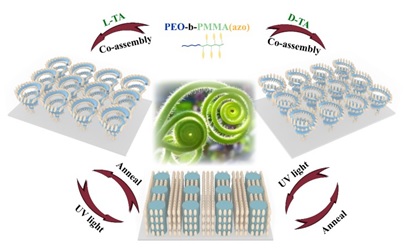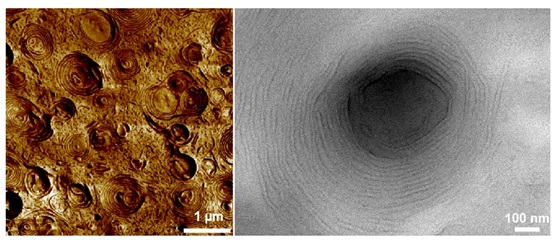The DNA double helix and α-helical polypeptide assembled with chiral molecules in living organisms are essential for a variety of physiological activities, for chirality is an important element in the composition of living organisms. In recent years, scientists have obtained various chiral assemblies such as helix, helical ring and Möbius band by employing synthetic organic molecules for the supramolecular self-assembly in solution. However, the chiral assembly and morphological evolution from molecules to spiro rings has been a mystery, and it is a challenge to construct chiral spiro rings in solid film to obtain chiroptics.
YUAN Jianan, a Ph.D. student in the School of Chemical Science and Engineering, under the supervision of Prof. LU Qinghua, has successfully constructed a micron-scale chiral three-dimensional (3D) spiro ring by mixing exogenous chiral molecules with liquid crystalline block copolymer film and then conducting a phase separation by thermal annealing. The chiral 3D spiro ring can be erased under UV light and be re-formed after thermal annealing, which is expected to realize the information storage of chiral structures. The research result named “Reversible Micron‐Scale Spiral Self‐Assembly in Liquid Crystalline Block Copolymer Film with Controllable Chiral Response” was published in the Angewandte Chemie International Edition, an internationally renowned journal of chemistry.
In their previous studies, the team initiated the method of assembly of Dual Chiral Spiral Columns with annealing following the mixing of exogenous chiral molecules with liquid crystalline double-block copolymer (Angewandte Chemie International Edition 2018, 57, 15148-15152), and used the film resulted from the method to study the chiral transfer and chiral fluorescence (ACS Nano 2020, 14, 8939-8948). Based on this, by the further compounding of the azo side-chain block copolymer PEO-b-PMMA (azo) with nematic characteristics and the exogenous chiral molecule (TA), they observed that at the early stage of thermal annealing, the microphase separation of the block copolymer results in a PEO/TA cylindrical structure because the chiral liquid crystal field of PMMA (azo)/TA has not been fully formed; with the extension of annealing time, the PMMA (azo) forms chiral liquid crystal field induced by chiral TA, and the cylindrical structure is bent and twisted under the torsional force of chiral liquid crystal field; and finally a complete 3D chiral spiro ring forms. The paper shows the phase separation of double-block copolymer under the chiral liquid crystal and explains the rules of conversion from chiral assembly to 3D spiro ring.

Fig.1 self‐assembly and reversible transformation of micrometer‐scale spiral structures in LC‐BCP film doped with chiral TA. Inset: Bud of Pteridium aquilinum.
Under UV light, the liquid crystalline characteristics of the continuous PMMA (azo) are disrupted due to the conversion of the azobenzene group from trans-isomer to cis-isomer in the liquid crystal mesogen, resulting in the receding of the 3D spiro ring structure. By reversing the azobenzene from cis-isomer to trans-isomer through annealing, the chiral liquid crystal characteristics are resumed and the spiral structure of the film appears again. The controllable self-assembly is an effective strategy for preparing reversible chiral 3D spiro rings, blazing a new trail for the development of advanced materials of chiral cryptography. The research is funded by the National Natural Science Foundation of China.

Fig. 2 TEM and AFM images of LC‐BCP films loaded with 54 wt % D‐TA (a, b) and L‐TA (d, e), respectively. Sketch map of spiral structures with clockwise (c) and anticlockwise (f) configurations. The slice sample was prepared by microtome with thickness of approximately 100 nm.
Link of the paper: https://doi.org/10.1002/anie.202101102